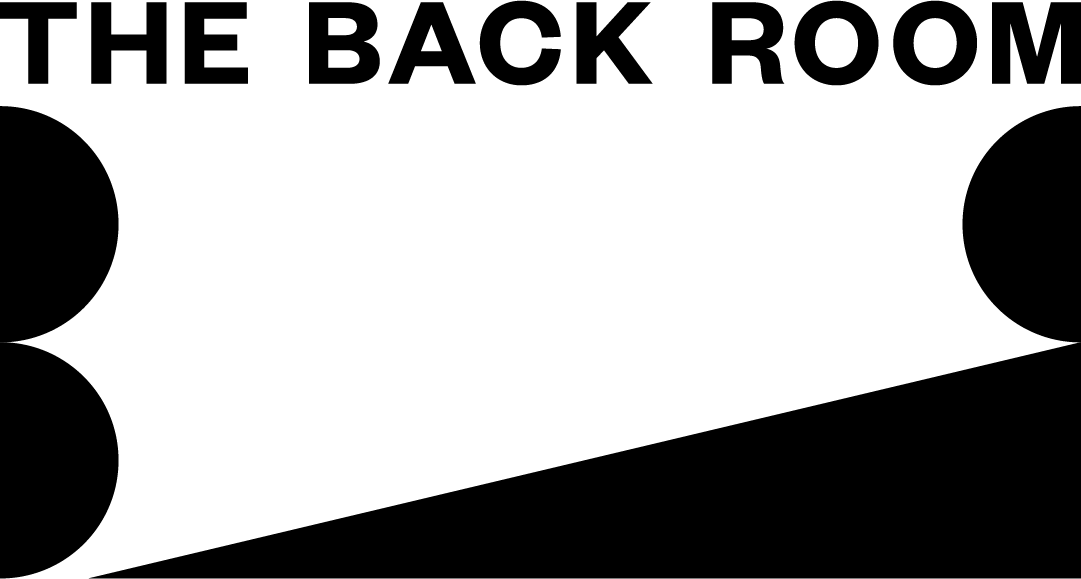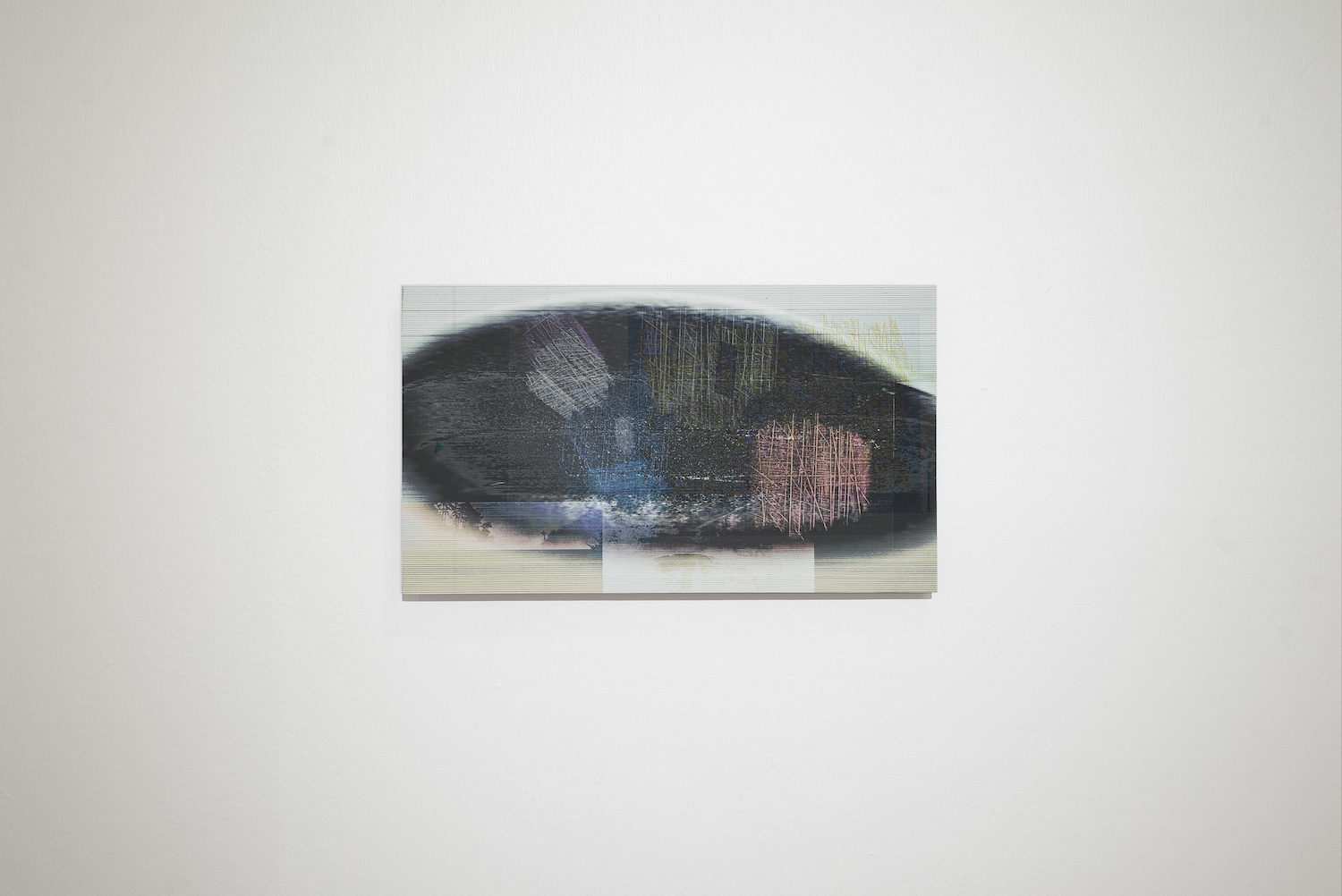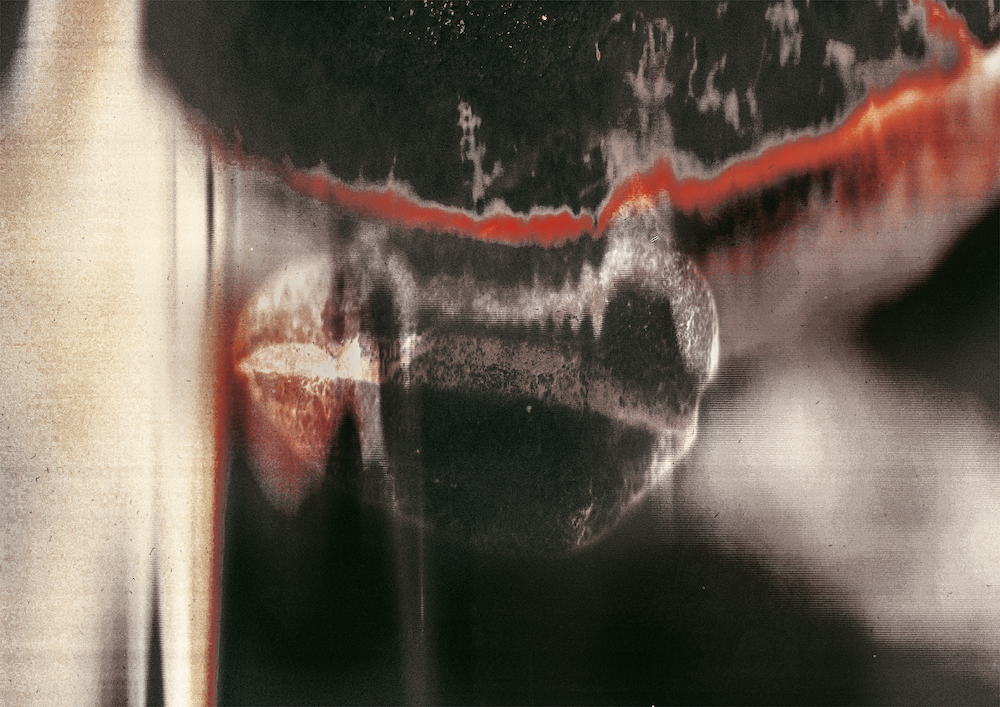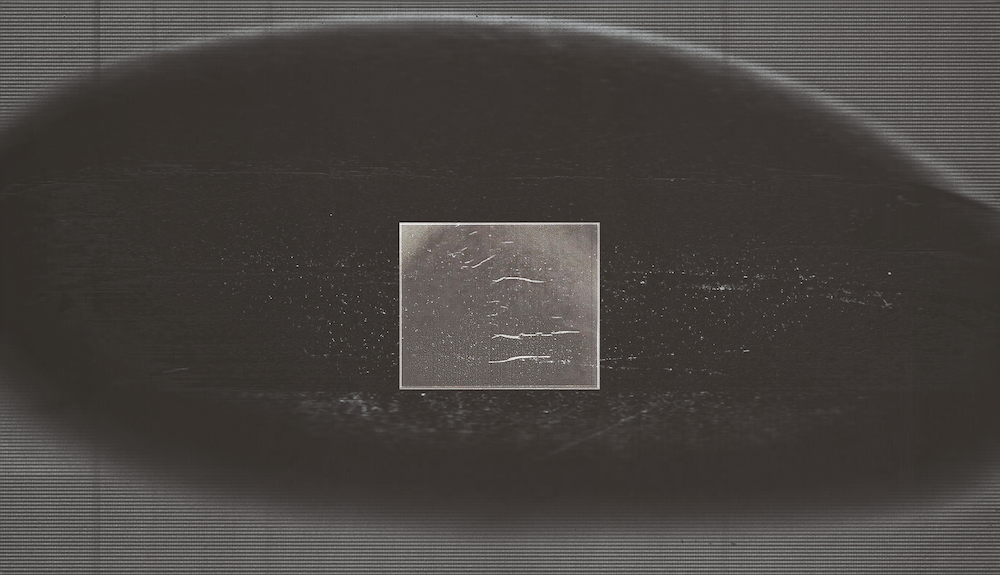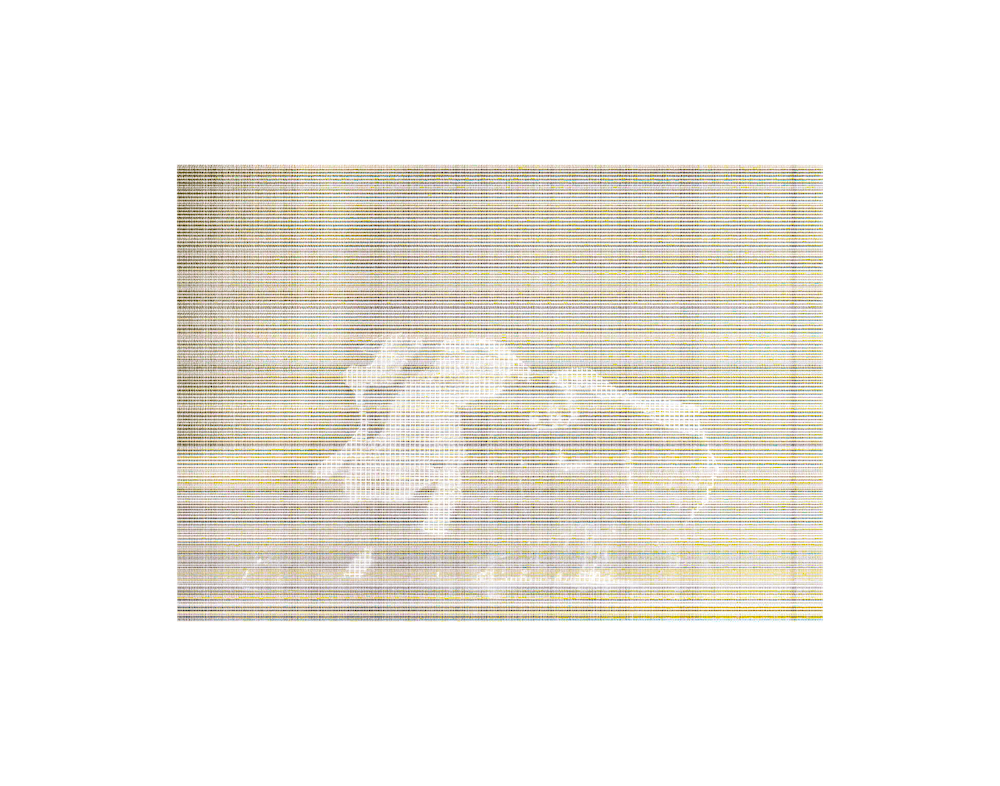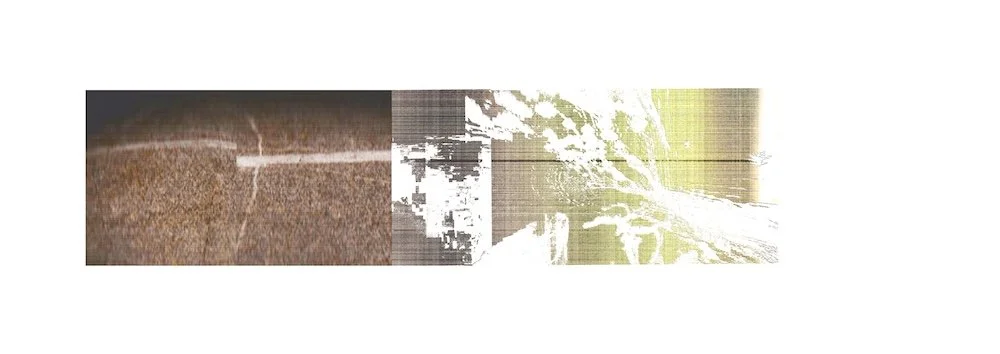Containment ———— Field brings together two print artists, Amanda Gayle (MY) and Liu Liling (SG) in an exhibition curated by Lim Sheau Yun. The title of the exhibition names one of many dyads that animate the work of these artists. One might think of each work in the exhibition as a container, an enclosed site of intent. A field, conversely, suggests openness, dispersal, and relationality, mapping between and outside the works. The field is where edges dissolve, where containment is tested, strained, or made porous. Together, the two terms speak to the condition of print in their practices: at once bounded by substrate and process yet always threatening to exceed them. Between the controlled gesture and the accidental mark, Gayle and Liu chart a space in which print is not only image but event: a negotiation between matter, machine, and time.
Liu’s practice extends the timescale of the photographic instant. Her work begins with a photograph, which is taken in the seconds the shutter allows light to pass. It is through the printing and scanning process that Liu manipulates these photographs. Using the scanner as a tool for productive mistranslations, she employs repetitive scanning and re-scanning to create variations of an image. A fine-art inkjet printer also becomes a compositional agent, used to create sudden interruptions and accumulative overprints with careful stops and starts of the machine. It is an exercise in control, in equal measure both about compressing the space of the print and gesturing toward its expansive possibilities. The works in Containment ———— Field, made from 2019 to 2025, form a series of interrogations about the line. In what ways can a line bleed? Can a two-dimensional line contain three-dimensional volume? Can it disappear?
Meanwhile, Gayle’s temporal concerns fluctuate between the infinite time of contemporary media and the primordial time of the geological. In Containment ———— Field, Gayle presents a series of works concerned with the materiality and metaphor of rocks. Rocks, with their slow accumulation of material over millennia, become analogues for her own practice, where found images from magazines, digital scans of rocks, hand-scans from a hand-held scanner, and incidental marks, such as those etched over years into her cutting mat, are metabolised into collages. Horizontal striations made through the lateral movements of print and scan beds echo sedimentary layers. The vignette of a rock becomes a compositional container, an irregular ovoid serving as an intimation of early photographic circular daguerreotypes. A trawler of media ad infinitum, Gayle sifts through visual debris to produce works that index both deep time and our contemporary condition of image saturation.
Exhibition dates
7 – 22 June 2025
About the Artists
Amanda Gayle (b. 1997, Malaysia) works between analogue and digital image-making processes, which reframe pre-existing ideas about the world. Her use of collage disrupts the trajectory of linear story-telling, inviting the viewer to elaborate and speculate on multiple woven narratives. There is often an unplanned approach to her practice which is heavily inspired by the human experience and her immediate surroundings, providing new aesthetic freedom whilst celebrating complexity and imperfection in the process.
She has previously shown in Malu Tapi Mahu (293, Kuala Lumpur, 2024), Immediate Conception (presented by A+ Works of Art, Blank Canvas, Penang, 2022), EVERYTHING HAS CHANGED NOTHING HAS CHANGED (Temu House, Kuala Lumpur, 2022), Copy / Paste / Displace (The Back Room, Kuala Lumpur, 2021), and HERE </> THERE (Today Art Museum, Beijing, China, 2019).
She received her Bachelor’s in Graphic Design Communication from Central Saint Martins, London, England, in 2020 and currently practices as a designer, specialising in publication and print design. She co-founded cloud projects, an independent publishing house based in Kuala Lumpur which focuses on art, architecture, and history within Southeast Asia.
Liu Liling (b. 1993, Singapore) works primarily with the photographic image to explore ideas of duration and experiential aspects of the medium, situating them with the installation site.
In her practice, she engages with various printing processes as a tool to arrive at a new picture plane, often suggesting points of departure, coming into, and stasis. Essential to the works are visual qualities inherent to the making process, materialising as a build-up of minutiae that foregrounds the work.
Liu graduated from LASALLE College of the Arts, Singapore with a Bachelor's in Fine Arts. In 2024, she opened a solo exhibition, After Light, at Mizuma Gallery, Singapore, and participated in a residency with Onomichi City University, Hiroshima, Japan.
About the Curator
Lim Sheau Yun (Sheau) is a curator, writer and architectural designer based between Kuala Lumpur and Cambridge, MA. She is a co-founder of cloud projects, a collective that researches in art, architecture, and history, and works across archives, exhibitions, and publications. She is a team member at Malaysia Design Archive, an independent visual culture archive. She holds a BA in Architecture, with concentration in History, Theory, Criticism, from Yale University, where her undergraduate thesis was awarded the John Addison Porter Prize. She is currently pursuing a Master’s in Architecture at Massachusetts Institute of Technology.
Sheau’s work has been supported by fellowships from Yale (2017–20), and grants from organisations including the DAAD Artists-in-Berlin Program (2020), the UCLA Modern Endangered Archive Program (2021), the Foundation for Arts Initiatives (2020), Malaysia's Cultural Economy Development Agency (CENDANA) (2022), and more.
Notable exhibition projects include The Plantation Plot (ILHAM Gallery, Kuala Lumpur, 2025), Tinggal Kenangan (A+ Works of Art, Kuala Lumpur, 2024), Strategies of Dissent: Works from the Ng Seksan Collection (+n by Ur-Mu, Kuala Lumpur, 2024), All the Lands Within the Seas (The Back Room, Kuala Lumpur, 2021), and more.
Installation
Installation shots by Philip.
Artworks
Exhibition essay
In Light Of…
by Lim Sheau Yun
A scanner illuminates an object or page with a light source, and a photosensitive sensor records reflected light as digital information, translatable to a screen. The fluorescent light moves laterally across the scanner bed, a digital whir contained in a closed environment. An inkjet printer uses thousands of little nozzles to spray vapourised ink onto the surface of a piece of paper, like pixels working in the physical. Colours are separated into four channels – cyan, magenta, yellow, black – and recombined in ratio to reproduce a specific colour, or wavelength, that is in turn reflected into our retinas.
Light encodes information, both digital and analogue. We often conceive light between the two poles of origin and result – a source of light and the object lit – but the two artists in Containment ——— Field, Amanda Gayle and Liu Liling, are far more interested in the translative abilities of light and its encoded information. Intervening upon the bland technologies of the scanner and printer, now democratised into most offices and many households, Gayle and Liu draw our attention to the material foundations of this equipment, these distributed engines of reproduction. “Pure occurrentness announces itself.” [1]
The artworks in Containment ——— Field, are thus themselves products of translations between image, object, scanner, printer, and eye. The mechanisms of light that produce sight – retinal art, in its purest sense – are taken apart, decoded and intervened upon. Gayle and Liu mount challenges to the transparency of the printed medium – that what we see is what we get – as a form of mass truth.
… Water
In her monologue Saying Water, American artist Roni Horn says, “Water is transparence derived from the presence of everything.” [2] Long fascinated with the material and metaphorical possibilities of water, Horn’s sculptural series Water Double mimic and distil the properties of water into cast glass. These cylindrical drums, rounded at the edges, form a smooth and sunken oculus at the very top. They reflect their environment into their looking glasses, bringing the outside world into their infinite interior, plastic in image and form. Motion stilled.
“Water is transparence derived from the presence of everything.” For Liu, water – and Horn’s writing on it – has been a touchstone. In Liu’s words, water’s “indeterminacy [is] what an image surface can be.” A water surface “both absorbs and reflects light,” allowing an awareness of both exterior and interior. In turn, water bodies, for Liu, are a “sculptural presence.”
For years, Liu has kept a series of photographic prints of water bodies she has encountered, taken from weekly walks where she seeks out sources of water. To her, these are sketches, a way to draw out ideas and impulses without assigning fixity, not works. They extend the moment. In Singapore, where Liu is based, major sources of water allocated for urban enjoyment – MacRitchie, Bedok, Jurong Lake – are reservoirs and catchment areas for infrastructural and national security purposes. Surrounded on all sides by trees, concrete, or both, they are large enough to suggest vastness, but small enough to observe as enclosure. They are, in essence, contained.
… Black
From Saying Water: “Black water is always violent, even when slow moving. Black water dominates, bewitches, subdues. Black water is alluring because it is disturbing and irreconcilable. Black water is violent because it is alluring, and because it is water. Darkness reflects the sun. Blackness reflects nothing.”
Innerbloom (2025) is what Liu calls a “wet print,” made from iteratively printing on coated paper, which, contrary to common practice, allows ink to sit on the paper’s surface rather than being absorbed into its fibres. These wet prints are left to dry for months, and sometimes, years. Sitting on the surface of the paper, attracted to itself and repelled by the paper’s coating, ink pools into moments of concentration, leaving behind hues of grey as trails of its migrations. A nestled series of soft frames scaffolds a darker pool that resembles the Chinese character 凹, a pictographic representation of the unevenness of surface. The composition is finished with a gestural thread of gold, suspended gently on the surface of the ink.
Conventionally, once a printer spits out an image, the work is deemed complete. Liu’s wet prints extend its temporality, and in doing so create gradations in the surface of the image. Innerbloom stages a deepening, a gravitational tug, much like what occurs when you attempt to, but cannot, see to the bottom of a body of black water. Surface, too, has depth: what Liu’s prints do is intensify surface onto a shallow body.
In doing so, Liu’s prints move out of being in a frame and become spatial, a literal and figurative dimensionality that is anti-perspectival but deeply retinal. Its field is through the surface of the image. Like a reservoir, these works are containers of expanse.
… Mass
As the Moon orbits the Earth, a gravitational pull is exerted between these two massive rocks which causes the oceans to bulge. As Tom Cookson writes, “the sea is a mass, which gives it a gravitational heft connecting it to the moon, yet it is also a surface... This illusion is broken… when the body we encounter is very shallow. Surface becoming mass and mass articulating surface.” [3]
Of the eight planets in our solar system, only four – the ones closest to the sun – are solid rock. Earth is the only astronomical object known to harbour life. We are witnesses to this great time.
… Rocks
Gayle’s works in Containment ——— Field began with a set of stones, some taken from rivers and others from the beach. Broken from larger rocks, presumably limestone formed from the remains of marine organisms, and moulded over centuries by the movement of water into soft edges, these stones are souvenir-sized pieces of geology, pieces of deep time that can be brought back to the apartments of Kuala Lumpur. The details in these rocks, from its sedimentary striations, its miniature fissures, its inclusions, become generative loci for these works.
In Relief (2025), Gayle insets a print within another, indexing a history of media. A scan of a three-dimensional rock lends the base image both textural granularity in the centre and a blurred edge, as the scanner light is no longer contained by the cover. Its vignette becomes a compositional container, an irregular ovoid serving as an intimation of early photographic circular daguerreotypes. Horizontal striations, made through the lateral movements of the scanner’s light source as it scans the glass bed, echo the piecemeal sedimentary layers that form rock. Nestled within the centre of the composition is a second frame, physically cut into the first image. It displays a close-up of rock striations: stretch marks on a rounded surface that become gestural marks analogous to the gold thread in Liu’s Innerbloom. Gayle’s work charts an idiosyncratic path through the history of media: the stone bas-reliefs of ancient Southeast Asia, early photography and negatives, digital imaging technologies, screens and the viewfinder. The infinite time of media and the primordial time of the geological collide with an observational present.
Previously, Gayle worked in long, linear strips of acetate. Using acetone and other inks, she enacted a physical subtraction and addition on acetate sheets before re-scanning and digitising the image. The works accumulated in small fragments taped together, brought into unison by a scan and a final print. Like unfurled rolls of film, the transparent images were draped over supports or mounted onto walls. The works in Containment ——— Field, rather than relying on the transparency of substrate to provide a layered image, instead use the materiality of sedimentary rock parallels her own practice: an accumulation of parts that settles into a single plane. Each print is built the way limestone is built: by thousands of discreet deposits that, once compressed, read as seamless stone. In slow, incremental, creep (2025) the page reads like a core sample: tones of blue and black compress into a small section of banding, while errant streaks – rubbings from three separate cracks of the concrete in her apartment – skitter across the matte black surface like seismic faults.
Gayle invites that slow, geological gaze. She withholds any single, frontal “image” and substitutes instead a field of overlaps that must be excavated optically, layer by layer. Containment, instead of infinite scroll, becomes a productive tension: the frame corrals events that nevertheless threaten to exceed it, just as a stone holds but also hints at the vanished cliff face from which it fell.
LIM SHEAU YUN
May 2025
Footnotes
Martin Heidegger, Sein und Zeit, 7th edition, (Tübingen: Max Niemeyer Verlag, 1953), 73, in Mark Wrathall, “Martin Heidegger,” Stanford Encyclopedia of Philosophy, 26 May 2025, https://plato.stanford.edu/entries/heidegger/.
Roni Horn, “Saying Water,” Batalha Centro de Cinema, 27 May 2025, https://www.batalhacentrodecinema.pt/en/editorial/ts-saying-water/.
Tom Cookson. Shallow Time: The Burren (Barcelona and Dubline: dpr-barcelona and Irish Architecture Foundation, 2023), 29.
